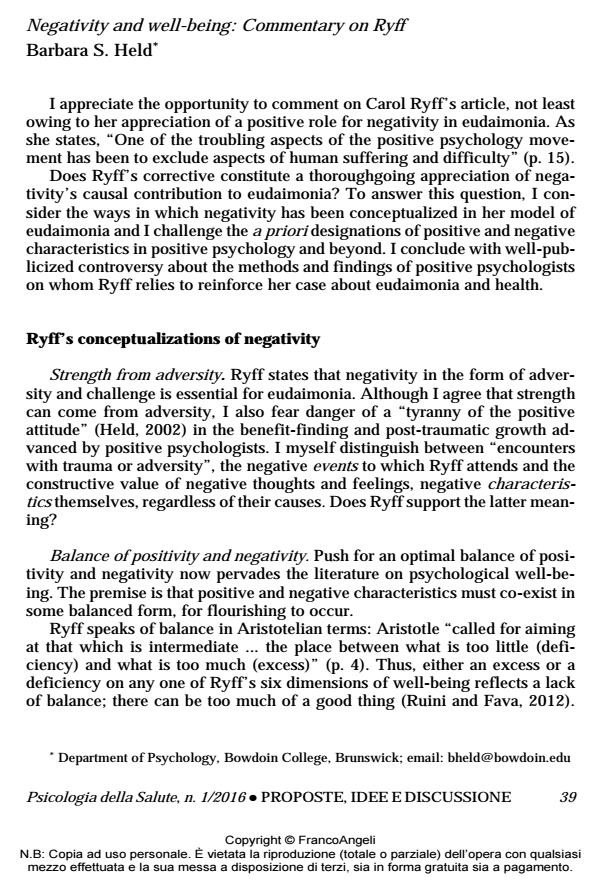Negativity and well-being: Commentary on Ryff
Titolo Rivista PSICOLOGIA DELLA SALUTE
Autori/Curatori Barbara S. Held
Anno di pubblicazione 2016 Fascicolo 2016/1 Lingua Inglese
Numero pagine 5 P. 39-43 Dimensione file 38 KB
DOI 10.3280/PDS2016-001005
Il DOI è il codice a barre della proprietà intellettuale: per saperne di più
clicca qui
Qui sotto puoi vedere in anteprima la prima pagina di questo articolo.
Se questo articolo ti interessa, lo puoi acquistare (e scaricare in formato pdf) seguendo le facili indicazioni per acquistare il download credit. Acquista Download Credits per scaricare questo Articolo in formato PDF

FrancoAngeli è membro della Publishers International Linking Association, Inc (PILA)associazione indipendente e non profit per facilitare (attraverso i servizi tecnologici implementati da CrossRef.org) l’accesso degli studiosi ai contenuti digitali nelle pubblicazioni professionali e scientifiche
- Held B. S. (in press b). Positive psychology’s a priori problem. Journal of Humanistic Psychology.
- Kok B. E., Coffey K. A., Cohn M. A., Catalino L. I., Vacharkulksemsuk T., Algoe S. B., Brantley M. and Fredrickson B. L. (2013). How positive emotions build physical health: Perceived positive social connections account for the upward spiral between positive emotions and vagal tone. Psychological Science, 24: 1123-1132. DOI: 10.1177/095679761247082
- McNulty J. K. and Fincham F. D. (2012). Beyond positive psychology? Toward a contextual view of psychological processes and well-being. American Psychologist, 67: 101-110. DOI: 10.1037/a002457
- Miyamoto Y. and Ryff C. D. (2011). Cultural differences in the dialectical and non-dialectical emotionalstyles and their implications for health. Cognition and Emotion, 25: 22-39. DOI: 10.1080/0269993100361211
- Norem J. K. (2008). Defensive pessimism, anxiety and the complexity of evaluating self-regulation. Social and Personality Psychology Compass, 2: 121-134. DOI: 10.1111/j.1751-9004.2007.00053.
- Norem J. K. (2014). The right tool for the job: Functional analysis and evaluating positivity/negativity. In W. G. Parrott (ed.), The positive side of negative emotions. NYC: Guilford, pp. 247-272.
- Norem J. K. and Chang E. C. (2002). The positive psychology of negative thinking. Journal of Clinical Psychology, 58: 993-1001. DOI: 10.1002/jclp.10094
- Peterson C. and Seligman M. E. P. (2004). Character strengths and virtues: A handbook and
- classification. Washington, DC: American Psychological Association/ NYC: Oxford University Press.
- Ruini C. and Fava G. A. (2012). Role of well-being therapy in achieving a balanced and individualized path to optimal functioning. Clinical Psychology and Psychotherapy, 19: 291-304. DOI: 10.1002/cpp.179
- Ryff C. D. (2014). Psychological well-being revisited: Advances in the science and practice of Eudaimonia. Psychotherapy and Psychosomatics, 83: 10-28. DOI: 10.1159/00035326
- Wood J. V., Perunovic W. Q. E. and Lee J. W. (2009). Positive self-statements: Power for some, peril for others. Psychological Science, 20: 860-866. DOI: 10.1111/j.1467-9280.2009.02370.
- Held B. S. (in press a). Why clinical psychology should not go “positive” – and/or “negative”. In A. Wood and J. Johnson (eds.), The Wiley Handbook of Positive Clinical Psychology. NYC: Wiley.
- Held B. S. (2004). The negative side of positive psychology. Journal of Humanistic Psychology, 44: 9-46. DOI: 10.1177/0022167803259645
- Held B. S. (2002). The tyranny of the positive attitude in America: Observation and speculation. Journal of Clinical Psychology, 58: 965-991. DOI: 10.1002/jclp.1009
- Heathers J. A. J., Brown N. J. L., Coyne J. C. and Friedman H. L. (2015). The elusory upward spiral: A reanalysis of Kok et al. (2013). Psychological Science, 26: 1140-1143. DOI: 10.1177/095679761557290
- Fredrickson B. L., Grewen K. M., Coffey K. A., Algoe S. B., Firestine A. M., Arevalo J. M. G., Ma J. and Cole S. W. (2013). A functional genomic perspective on human well-being. Proceedings of the National Academy of Sciences, 110: 13684-13689. DOI: 10.1073/pnas.130541911
- Fredrickson B. L. (2013). Updated thinking on positivity ratios. American Psychologist, 68, 814-822. DOI: 10.1037/a0033584
- critical reanalysis of the relationship between genomics and well-being. Proceedings of the National Academy of Sciences, 111: 12705-12709. DOI: 10.1073/pnas.140705711
- Brown N. J. L., MacDonald D. A., Samanta M. P., Friedman H. L. and Coyne J. C. (2014). A
- Brown N. J. L., Sokal A. D. and Friedman H. L. (2014). The persistence of wishful thinking: Response to “Updated Thinking on Positivity Ratios”. American Psychologist, 69: 629-632. DOI: 10.1037/a0037050
Barbara S. Held, Negativity and well-being: Commentary on Ryff in "PSICOLOGIA DELLA SALUTE" 1/2016, pp 39-43, DOI: 10.3280/PDS2016-001005